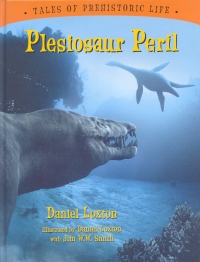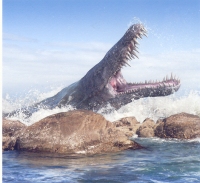| ________________
CM . . .
. Volume XX Number 40. . . .June 13, 2014
excerpt:
Plesiosaur Peril follows the journey of a baby Cryptoclidus with her mother and their pod. The Cryptoclidus and other plesiosaurs are featured throughout this highly entertaining and informative book.
Plesiosaur Peril is the third title in Loxton’s “Tales of Prehistoric Life” series. As with its predecessors, Ankylosaur Attack and Pterosaur Trouble, this title features dynamic writing and creative artwork. This book is a worthy successor to the high quality books with which it has been preceded. Loxton has the reader wondering what will happen to the baby Cryptoclidus when she strays too far from her mother and their pod. Together with the dramatic illustrations, Loxton’s writing leaves readers on the edge of their seats wondering if the baby will survive. In addition to learning about plesiosaurs, the story teaches children about the importance of family bonds. For the sake of storytelling, Loxton strikes a superb balance between intensity and heartfelt tenderness in his description of prehistoric life. Loxton collaborated with Jim W. W. Smith on the realistic artwork. Digital art and underwater photography create a life-like picture of a world of plesiosaurs. The colourful, sharp, and detailed illustrations allow readers to escape into a prehistoric world surrounded by all manner of wildly wonderful creatures. This enables readers to gain a deeper understanding of Jurassic times. The stunning blues and greens complement the vivid storytelling and help engage young readers in the book. Loxton’s detailed prose allows readers to discover the life of prehistoric creatures in an interesting and exciting way. He creates the perfect blend of scientific facts with child-friendly storytelling. These facts are borne of supposition based on fossil discoveries. In his acknowledgments, Loxton expresses particular thanks to paleontologist Darren Naish for his expert advice and generous assistance with the project. We think that this book will have wide appeal. One of us shared the book with a three-and-a-half year old nephew. He was able to make connections between the realistic book illustrations and his own dinosaur toys. We know also that many upper elementary students are passionate in their enthusiasm for dinosaurs, and so we expect that readers as young as two or three and as old as 11 or 12 will thoroughly enjoy this book. Readers will be engaged in the story whilst simultaneously learning some scientific and historical facts about these ancient creatures. As readers follow the baby Cryptoclidus and his mother on their journey, they gain a wealth of knowledge on various prehistoric creatures and their relationships with each other. The extra information in the afterword at the end of the book helps answer questions that children may have about plesiosaurs and the way that scientists use fossils to uncover information. Highly Recommended. Dr. Gregory Bryan is a member of the Faculty of Education at the University of Manitoba, where he teaches children’s literature classes.
To comment
on this title or this review, send mail to cm@umanitoba.ca.
Copyright © the Manitoba Library Association. Reproduction for personal
use is permitted only if this copyright notice is maintained. Any
other reproduction is prohibited without permission.
NEXT REVIEW |
TABLE OF CONTENTS FOR THIS ISSUE
- June 13, 2014.
AUTHORS |
TITLES |
MEDIA REVIEWS |
PROFILES |
BACK ISSUES |
SEARCH |
CMARCHIVE |
HOME |

 Distantly related to dinosaurs, plesiosaurs were the top ocean predators of the Jurassic period. The Cryptoclidus are depicted swimming through the water in a strong family unit until the deadly hunter Liopleurodon enters the scene. Author Daniel Loxton reveals various details about the Cryptoclidus’ lives. These details include such things as their body structure and size, their food sources, their reproductive habits, and the other creatures with which they shared their marine habitat. Readers also learn that the Cryptoclidus was prey for other larger, deadlier marine reptiles, including the Liopleurodon.
Distantly related to dinosaurs, plesiosaurs were the top ocean predators of the Jurassic period. The Cryptoclidus are depicted swimming through the water in a strong family unit until the deadly hunter Liopleurodon enters the scene. Author Daniel Loxton reveals various details about the Cryptoclidus’ lives. These details include such things as their body structure and size, their food sources, their reproductive habits, and the other creatures with which they shared their marine habitat. Readers also learn that the Cryptoclidus was prey for other larger, deadlier marine reptiles, including the Liopleurodon.